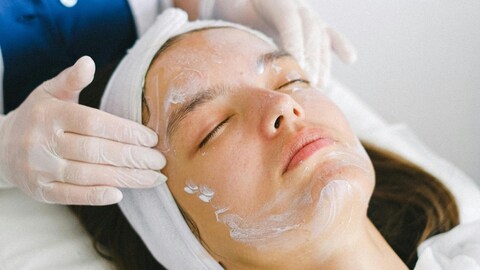What's the difference between chemical and physical exfoliation? Experts weigh in
Here's how you can choose the best method for your skin.

Exfoliation is an essential part of any skincare routine. But with so many options available, choosing the right method that works for your skin type and concerns, can be challenging. Should you opt for chemical exfoliation or stick to the traditional physical approach? Understanding the difference between these techniques can make all the difference, helping you achieve that smooth, glowing, complexion.
Each method has its own set of benefits and is suited to different skin types and concerns. To help you navigate these choices, we've consulted with dermatologists who've shared their expertise on these methods, their advantages, and more.
Both chemical and physical exfoliation can aid in the process, but what is the difference between the two?
Chemical exfoliation uses acids or enzymes to dissolve the bonds between dead skin cells, allowing them to be shed more easily. It can penetrate deeper into the skin, providing a more thorough exfoliation compared to physical methods. According to Suvina Attar, a dermat from Bayla Skin, “Chemical facials are usually performed in dermatology clinics and are tailored to various skin types and conditions. Retinoids, another chemical type, increase cellular turnover, aiding in anti-ageing. Physical exfoliation, on the other hand, physically removes dead skin cells using tools like pads, scrubs, brushes, or procedures such as microdermabrasion and dermaplaning.”
Physical exfoliation, on the other hand, involves physical methods like microdermabrasion or facial scrubs to manually slough off dead skin cells. “It’s great for immediate smoothness and can enhance product absorption, but it's typically more surface-level compared to chemical exfoliants,” states celebrity aesthetician and co-founder of BiE, Dinyar Workingboxwalla.
Added benefits
Both chemical and physical exfoliation have unique benefits and can be incorporated into a skincare routine based on individual skin types and concerns. While chemical exfoliation is excellent for targeted treatment and deeper penetration, physical exfoliation provides instant results and improves overall skin health through manual stimulation. Understanding these differences can help in choosing the right exfoliation method for optimal skin care.
While both methods can help remove dead skin cells, improve skin texture, and promote cell turnover, chemical exfoliants do seem to have added benefits. According to Dr Manu S Walia, “Chemical exfoliation removes dead skin cells, unclogs pores, treats pigmentation, clears acne, evens skin tone, and stimulates collagen. Its deep penetration makes it effective for pigmentation. In-clinic physical exfoliation is great for acne scars and improves skin texture and feel.”
Which method is recommended for whom?
Chemical and physical exfoliation are both effective methods for maintaining healthy skin, but they cater to different skin types and concerns. Chemical exfoliation is more result-based and is typically recommended for individuals with severe concerns. Physical exfoliation, comprising your daily facial scrubs, is just a part of your daily routine and is good for an instant glow.
If one is prone to acne and pigmentation, then chemical exfoliation is a better alternative. In-clinic peels have a higher concentration of active ingredients, which offer quicker, more intense results. After that, daily cleansers, creams, or serums with lower active concentrations may be recommended for regular use,” says Dr Walia.
How often do you need it?
The frequency of exfoliation depends on your skin type. “Chemical facials can typically be done every four to six weeks, depending on your skin type and the strength of the treatment. For milder chemical exfoliants, at-home use can be as frequent as once or twice a week,” says Workingboxwalla. He further adds, “Physical exfoliation should be done one to two times a week for most skin types. However, if you have sensitive skin, once a week or every other week might be more appropriate to avoid irritation.”
However, Dr Walia emphasises that neither of the two methods should be used too often or together since this can lead to over-exfoliation, which can lead to sensitivity, rashes, and skin eruptions.
Incorporating expert advice, understanding your skin type, and choosing the right exfoliation method are crucial steps in maintaining healthy, glowing skin. Whether you opt for chemical or physical exfoliation, remember to be gentle and attentive to your skin's needs. Regular but careful exfoliation can make a significant difference, leaving your skin radiant and rejuvenated. Always consult with a dermatologist to tailor your routine to your unique skin type for the best results. Happy exfoliating!
Featured image credit: Anna Shvets/Pexels
Inside images credits: Unsplash
Also read: Dermat-approved substitute ingredients if retinol doesn’t suit your skin
Also read: 6 Dermat-approved Ways to Get Smoother, Softer and Fuller Lips